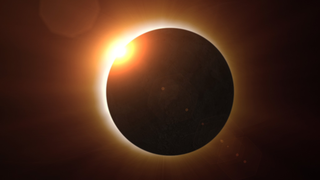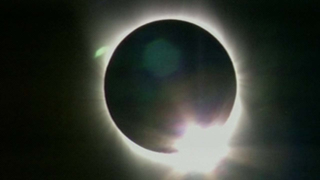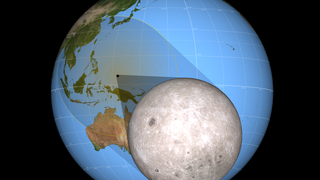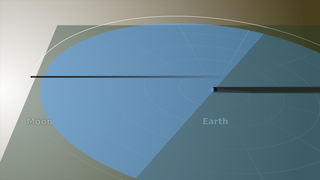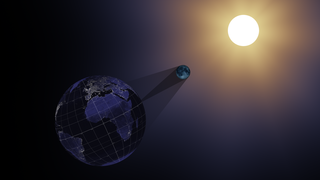Earth
Sun
Planets and Moons
ID: 4427
On Wednesday, March 9, 2016 (Tuesday evening in the Americas), the Moon will pass in front of the Sun, casting its shadow across Southeast Asia and the western Pacific. The shadow crosses the International Date Line, entering March 8, and passes Hawaii before it slides off the edge of the Earth.
The Moon's shadow can be divided into areas called the umbra and the penumbra. Within the penumbra, the Sun is only partially blocked, and observers experience a partial eclipse. The much smaller umbra lies at the very center of the shadow cone, and anyone there sees the Moon entirely cover the Sun in a total solar eclipse.
In the animation, the umbra is the small black oval. The red streak behind this oval is the path of totality. Anyone within this path will see a total eclipse when the umbra passes over them. The much larger shaded bullseye pattern represents the penumbra. Steps in the shading denote different percentages of Sun coverage (eclipse magnitude), at levels of 90%, 75%, 50% and 25%. The yellow and orange contours map the path of the penumbra. The outermost yellow contour is the edge of the penumbra path. Outside this limit, no part of the Sun is covered by the Moon.
The numbers in the lower left corner give the latitude and longitude of the center of the umbra as it moves eastward, along with the altitude of the Sun above the horizon at that point. Also shown is the duration of totality: for anyone standing at the center point, this is how long the total solar eclipse will last. Note that the duration varies from just 2 minutes over eastern Indonesia to over 4 minutes on the Woleai Atoll in Micronesia.
Go here for details about the methods and parameters used to make this visualization.
March 2016 Total Solar Eclipse Path
The Moon's shadow can be divided into areas called the umbra and the penumbra. Within the penumbra, the Sun is only partially blocked, and observers experience a partial eclipse. The much smaller umbra lies at the very center of the shadow cone, and anyone there sees the Moon entirely cover the Sun in a total solar eclipse.
In the animation, the umbra is the small black oval. The red streak behind this oval is the path of totality. Anyone within this path will see a total eclipse when the umbra passes over them. The much larger shaded bullseye pattern represents the penumbra. Steps in the shading denote different percentages of Sun coverage (eclipse magnitude), at levels of 90%, 75%, 50% and 25%. The yellow and orange contours map the path of the penumbra. The outermost yellow contour is the edge of the penumbra path. Outside this limit, no part of the Sun is covered by the Moon.
The numbers in the lower left corner give the latitude and longitude of the center of the umbra as it moves eastward, along with the altitude of the Sun above the horizon at that point. Also shown is the duration of totality: for anyone standing at the center point, this is how long the total solar eclipse will last. Note that the duration varies from just 2 minutes over eastern Indonesia to over 4 minutes on the Woleai Atoll in Micronesia.
Go here for details about the methods and parameters used to make this visualization.
Used Elsewhere In
Related
Visualization Credits
Ernie Wright (USRA): Lead Visualizer
Tom Bridgman (Global Science and Technology, Inc.): Visualizer
Alex Kekesi (Global Science and Technology, Inc.): Visualizer
Ernie Wright (USRA): Programmer
Genna Duberstein (USRA): Producer
Tom Bridgman (Global Science and Technology, Inc.): Visualizer
Alex Kekesi (Global Science and Technology, Inc.): Visualizer
Ernie Wright (USRA): Programmer
Genna Duberstein (USRA): Producer
Please give credit for this item to:
NASA/Goddard Space Flight Center Scientific Visualization Studio
NASA/Goddard Space Flight Center Scientific Visualization Studio
Short URL to share this page:
https://svs.gsfc.nasa.gov/4427
Data Used:
Note: While we identify the data sets used in these visualizations, we do not store any further details nor the data sets themselves on our site.
Keywords:
SVS >> HDTV
SVS >> Moon
SVS >> Solar Eclipse
SVS >> Hyperwall
SVS >> Eclipse
SVS >> Heliophysics
SVS >> Sun-Earth-Moon Interactions
SVS >> Sun and Earth
NASA Science >> Earth
NASA Science >> Sun
NASA Science >> Planets and Moons
SVS >> Presentation
https://svs.gsfc.nasa.gov/4427
Data Used:
Terra and Aqua/MODIS/Blue Marble: Next Generation also referred to as: BMNG
Credit:
The Blue Marble data is courtesy of Reto Stockli (NASA/GSFC).
The Blue Marble data is courtesy of Reto Stockli (NASA/GSFC).
JPL DE421 also referred to as: DE421
Ephemeris - NASA/JPL
Planetary ephemerides
Keywords:
SVS >> HDTV
SVS >> Moon
SVS >> Solar Eclipse
SVS >> Hyperwall
SVS >> Eclipse
SVS >> Heliophysics
SVS >> Sun-Earth-Moon Interactions
SVS >> Sun and Earth
NASA Science >> Earth
NASA Science >> Sun
NASA Science >> Planets and Moons
SVS >> Presentation
